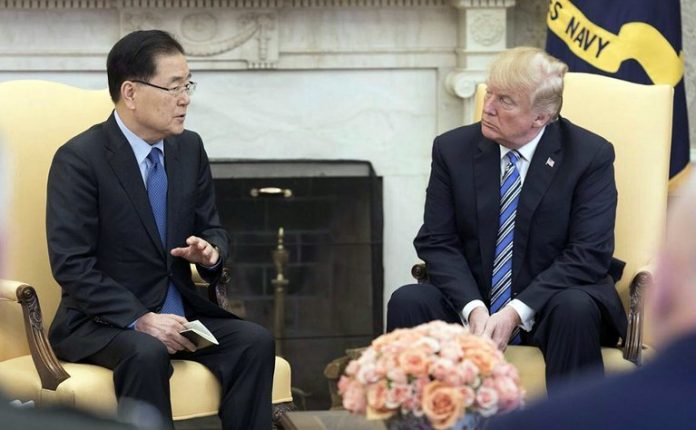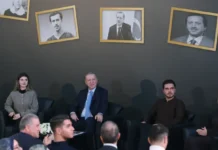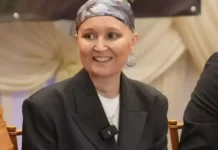By PETER BAKER and CHOE SANG-HUN MARCH 10, 2018
WASHINGTON — Summoned to the Oval Office on the spur of the moment, the South Korean envoy found himself face to face with President Trump one afternoon last week at what he thought might be a hinge moment in history.
Chung Eui-yong had come to the White House bearing an invitation. But he opened with flattery, which diplomats have discovered is a key to approaching the volatile American leader. “We could come this far thanks to a great degree to President Trump,” Mr. Chung said. “We highly appreciate this fact.”
Then he got to the point: The United States, South Korea and their allies should not repeat their “past mistakes,” but South Korea believed that North Korea’s mercurial leader, Kim Jong-un, was “frank and sincere” when he said he wanted to talk with the Americans about giving up his nuclear program. Mr. Kim, he added, had told the South Koreans that if Mr. Trump would join him in an unprecedented summit meeting, the two could produce a historic breakthrough.
Mr. Trump accepted on the spot, stunning not only Mr. Chung and the other high-level South Koreans who were with him, but also the phalanx of American officials who were gathered in the Oval Office.
His advisers had assumed the president would take more time to discuss such a decision with them first. Defense Secretary Jim Mattis and Lt. Gen. H.R. McMaster, the president’s national security adviser, both expressed caution. If you go ahead with this, they told Mr. Trump, there will be risks and downsides.
Mr. Trump brushed them off. I get it, I get it, he said.
Where others see flashing yellow lights and slow down, Mr. Trump speeds up. And just like that, in the course of 45 minutes in the Oval Office, Mr. Trump threw aside caution and dispensed with decades of convention to embark on a daring, high-wire diplomatic gambit aimed at resolving one of the world’s most intractable standoffs.
The story of how this came about, assembled through interviews with officials and analysts from the United States, South Korea, Japan and China, is a case study in international relations in the Trump era. A president with no prior foreign policy experience takes on a festering conflict that has vexed the world for years with a blend of impulse and improvisation, and with no certain outcome. One moment, he is hurling playground insults and threatening nuclear war, the next he is offering the validation of a presidential meeting.
Whether the high-stakes gamble ultimately pays off, no one can know. Given two unpredictable and highly combustible leaders, it seems just as likely that the meeting will never take place. If it does occur, the challenges are so steep, the gulf so wide and the history so fraught with misunderstanding, suspicion and broken promises that the prospect of an enduring resolution to the impasse seems remote.
But Mr. Trump has staked his reputation as a deal maker on the presumption that he can personally achieve what no other president has before him.
A Thorny Road
The path to a possible meeting led through a thicket of hostility and feints.
Throughout his first year in office, Mr. Trump ratcheted up economic sanctions while rattling his nuclear saber at “Little Rocket Man” and threatening to “totally destroy North Korea.”
Mr. Kim could match the president he called “the mentally deranged U.S. dotard” bombast for bombast. In a New Year’s Day speech, he said he had “a nuclear button on the desk” that could launch missiles capable of reaching the United States. Mr. Trump responded with a tweet saying that “I too have a Nuclear Button, but it is a much bigger & more powerful one than his.”
But South Korea’s president, Moon Jae-in, focused on the other part of Mr. Kim’s speech, when he declared that he would send athletes to the Winter Olympics, which would be held the next month in South Korea. A flurry of negotiations ensued at Panmunjom, the “truce village” inside the Korean demilitarized zone, that, by the standards of inter-Korean talks, went unusually well.
At the Winter Olympics in South Korea, Vice President Mike Pence made a point of refusing to greet Kim Yo-jong, the sister of the North Korean leader, Kim Jong-un. Credit Odd Andersen/Agence France-Presse – Getty Images
For the opening ceremony, on Feb. 9, Mr. Kim sent his sister, Kim Yo-jong, while Mr. Trump sent Vice President Mike Pence. The vice president was told of a possible meeting with North Korean officials at the Games if he would tone down his message, not talk about sanctions, not meet with defectors and not bring along Fred Warmbier, whose son, Otto, an American student, died soon after being released from captivity in North Korea.
Mr. Pence opted to do all of those anyway to show resolve, and the North Koreans canceled the meeting at the last minute. Taking the hard-line position he believed the president wanted him to take, a grim-faced Mr. Pence refused to stand for the entry of the joint Korean team that included athletes from both North and South and made a point of refusing to greet Mr. Kim’s sister, who was just 10 feet away.
Mr. Pence’s failure to stand was taken as an insult to Mr. Moon and the South Korean public, undercutting the vice president’s intent to show solidarity with an ally. Mr. Moon had been determined to bring the Americans and North Koreans together, to the irritation of the American delegation, which believed that he was deliberately trying to stage-manage an encounter they considered awkward and inappropriate.
Mr. Moon, by contrast, hosted Ms. Kim for a lavish luncheon at the presidential Blue House, and she surprised him with a letter from her brother. She told Mr. Moon that her brother wanted to convene a summit meeting at an early date. The two spent nearly three hours together, with Mr. Moon doing most of the talking.
He said that he really wanted to meet Mr. Kim and improve ties, but that there was a limit to how far he could go without progress in dismantling the North’s nuclear program. He urged North Korea to talk to the Americans and said they needed to hurry so as not to lose the rare momentum from the spirit of the Olympics visits.
A Family Envoy
After the unfortunate optics from Mr. Pence’s visit and what some viewed as a missed opportunity, Mr. Trump sent his daughter, Ivanka Trump, to the closing ceremony of the Games. She had dinner with Mr. Moon at the Blue House and briefed him on new sanctions her father would impose on North Korea, then made a public statement to reporters reaffirming the American strategy of “maximum pressure.”
She then headed to Pyeongchang for the last two days of competition. Briefed by Mr. Pence’s staff, Ms. Trump and her team were “incredibly forceful,” as one official put it, in going over the seating plan for the box and the timing and sequencing of arrivals to avoid any surprises.
Ms. Trump proffered a smiling, more open image that went over better in South Korea. She stood for the South Korean athletes, who this time entered the stadium separately from their compatriots from the North, and posed for photographs with famous Korean pop stars. But she too made a point of sending a message; for her guest in the box, she brought Gen. Vincent K. Brooks, commander of American forces in South Korea.
When she attended a curling event, Ms. Trump’s team received word that the North Koreans were on their way in what the Americans thought was an effort to make a scene or prompt her to leave in an embarrassing spectacle. Ms. Trump decided to stay, and the North Koreans in the end did not come.
All Smiles in the North
With the Olympics over, it was time for Mr. Moon to make his move. Last week, he sent two trusted aides on a two-day trip to Pyongyang: Mr. Chung, his national security adviser, and Suh Hoon, his National Intelligence Service director. Flying north, they knew that they were meeting Mr. Kim but not when.
After landing in Pyongyang, they were taken to a riverside guesthouse where they found their rooms equipped with the internet and access to foreign television channels, including CNN. They could even surf South Korean websites, a rare privilege in the totalitarian state. As soon as they unpacked, Kim Yong-chol, a general who heads inter-Korean relations, showed up and said that they were meeting Mr. Kim that evening.
Black limousines took the South Koreans to Azalea Hall in the ruling Workers’ Party headquarters, Mr. Kim’s workplace. They found Mr. Kim and his sister waiting to greet them with broad smiles. Mr. Chung and Mr. Suh were the first South Koreans to set foot inside the party headquarters since the Korean War.
Mr. Chung and Suh Hoon, the director of South Korea’s National Intelligence Service, announced outside the White House that Mr. Trump had accepted an invitation to meet with the North Korean leader. Credit Doug Mills/The New York Times
Mr. Chung had barely launched into his talking points when Mr. Kim said “I know” and “I understand you.” Then he laid out his proposal: talks with the United States on denuclearizing his country; a suspension of nuclear and missile tests during the talks; and his understanding that the United States and South Korea must proceed with annual joint military exercises.
The South Koreans found Mr. Kim to be an extremely confident leader. He was closely following foreign news media, knew how he was depicted, and even joked about it. He had studied Mr. Moon’s speeches and overtures toward the North.
He even joked about his missile launches. “I was sorry to hear that President Moon Jae-in had to convene his National Security Council meetings early in the morning because of our missile launchings,” he told the South Koreans. “Now, he won’t lose his early morning sleep any more.”
Top of Form
Bottom of Form
Top of Form
Mr. Kim agreed to open a direct hotline to Mr. Moon. “Now if working-level talks are deadlocked and if our officials act like arrogant blockheads, President Moon can just call me directly and the problem will be solved,” he said.
And, he added, he was eager to hold a summit meeting with his South Korean counterpart. The South Koreans suggested Pyongyang, Seoul and Panmunjom as possible sites and asked Mr. Kim to choose. Mr. Kim said he would come to the Peace House, a South Korean building inside Panmunjom.
The meeting and dinner, complete with wines and traditional Korean liquor, lasted from 6 p.m. to 10:12 p.m. with much laughter and bonhomie.
After returning to Seoul on Tuesday, the South Korean officials briefed Mr. Moon and then South Korean reporters. After his news conference, Mr. Chung called General McMaster and told him that he was carrying a message from Mr. Kim to Mr. Trump. Only several people at the Blue House knew that the message included a proposal for a meeting with Mr. Trump.
Off to Washington
Mr. Chung and Mr. Suh flew to Washington, arriving Thursday morning. By the afternoon, they were at the White House, meeting separately with General McMaster and Gina Haspel, the deputy C.I.A. director. The four then got together and were soon joined by other American officials, including Mr. Pence, Mr. Mattis, Dan Coats, the national intelligence director, Gen. Joseph F. Dunford Jr., the Joint Chiefs of Staff chairman, and John F. Kelly, the White House chief of staff.
Joined by their ambassador to Washington, the South Korean visitors were not supposed to meet with Mr. Trump until Friday, but when he heard they were in the building, he called them to the Oval Office.
Mr. Kim’s invitation to meet was not a complete surprise to Mr. Trump’s team. An American official said they had learned about it from intelligence agencies, so on Thursday morning, before the arrival of the South Koreans, Mr. Trump talked by phone with Secretary of State Rex W. Tillerson, who was traveling in Africa, about the possibility. What he did not tell Mr. Tillerson was that he would accept.
Mr. Trump was eager enough, however, that once he said yes, they discussed a meeting as early as next month. The South Koreans suggested it would be better to wait until after Mr. Moon’s summit meeting with Mr. Kim in April, which led to a target of May.
Not only did Mr. Trump surprise the South Koreans by accepting immediately, he even suggested that they make the public announcement right there and then at the White House.
Mr. Chung and Mr. Suh met with Mr. Kim in Pyongyang on Monday. They were the first South Koreans to set foot inside the party headquarters since the Korean War. Credit Korean Central News Agency
A stunned Mr. Chung retreated to General McMaster’s office to draft a statement in collaboration with the Americans. Then, using a secure telephone line, he called Mr. Moon early in the morning in Seoul to get his approval.
Elated, Mr. Trump stuck his head into the White House briefing room to tell reporters there would be an important announcement soon, something he had never done before.
Some of the president’s advisers objected to the idea of a foreign official making a statement from the White House lectern, so they had him do it instead on the White House driveway, where visitors typically speak with reporters. Still, it was highly unusual for a foreign official to announce an American president’s decision in a major international situation.
Out of the Loop
Mr. Trump’s quick decision caught many off guard, including Mr. Tillerson and American allies. Television networks set up live feeds from the White House driveway to carry Mr. Chung’s announcement. Congressional leaders and top officials at the Pentagon and the State Department learned what was happening from news reports.
The fact that it came on the same day that the president slapped stiff new tariffs on imported steel that would hit South Korea and Japan hard indicated how hasty and unplanned it was.
While Mr. Chung headed to the driveway, Mr. Trump hurriedly called Prime Minister Shinzo Abe of Japan to let him know. Mr. Abe has worked assiduously to cultivate a close relationship with Mr. Trump and taken a hard line on North Korea, but he was left out of the loop, a fact that stung.
“I have an impression that the Japanese are not quite well informed,” said Mine Yoshiki, head of a previous Japanese delegation seeking normalized relations with North Korea. “What we have been told is awfully out of tune, I should say.”
Mr. Trump did not reach President Xi Jinping of China until the next morning. China has backed Mr. Trump on North Korea, generating good will between Mr. Trump and Mr. Xi. But China refused last month to go along with an American plan to interdict oil tankers bound for North Korea on the high seas, demonstrating that there were limits to how far China would go in punishing Mr. Kim, given the risk of a North Korean collapse on its borders.
Mr. Trump said his conversation with Mr. Xi went well. “President XI told me he appreciates that the U.S. is working to solve the problem diplomatically rather than going with the ominous alternative,” the president wrote on Twitter on Saturday. “China continues to be helpful!”
But in response to Mr. Trump’s planned meeting, China is engaged in what some call “exclusion anxiety,” worried about being shut out. China would like the meeting to be held in Beijing, where six-nation talks were held with North Korea during President George W. Bush’s administration, but Chinese analysts doubt Mr. Kim would agree.
For now, Mr. Trump is juggling these dynamics and preparing to meet the world’s most hermetic leader. To his advisers, Mr. Trump has said he is impressed that Mr. Kim at such a young age has outmaneuvered almost everyone, but he has added that the North Korean leader is a wild card.
Of course, so is he. Mr. Trump vacillates between confidence and fatalism when it comes to North Korea. For the moment, he is optimistic.
“North Korea has not conducted a Missile Test since November 28, 2017 and has promised not to do so through our meetings,” he wrote on Twitter on Saturday. “I believe they will honor that commitment!”
Peter Baker reported from Washington, and Choe Sang-Hun from Seoul, South Korea. Reporting was contributed by Jane Perlez from Beijing, Motoko Rich from Tokyo, and David E. Sanger and Mark Landler from Washington.













